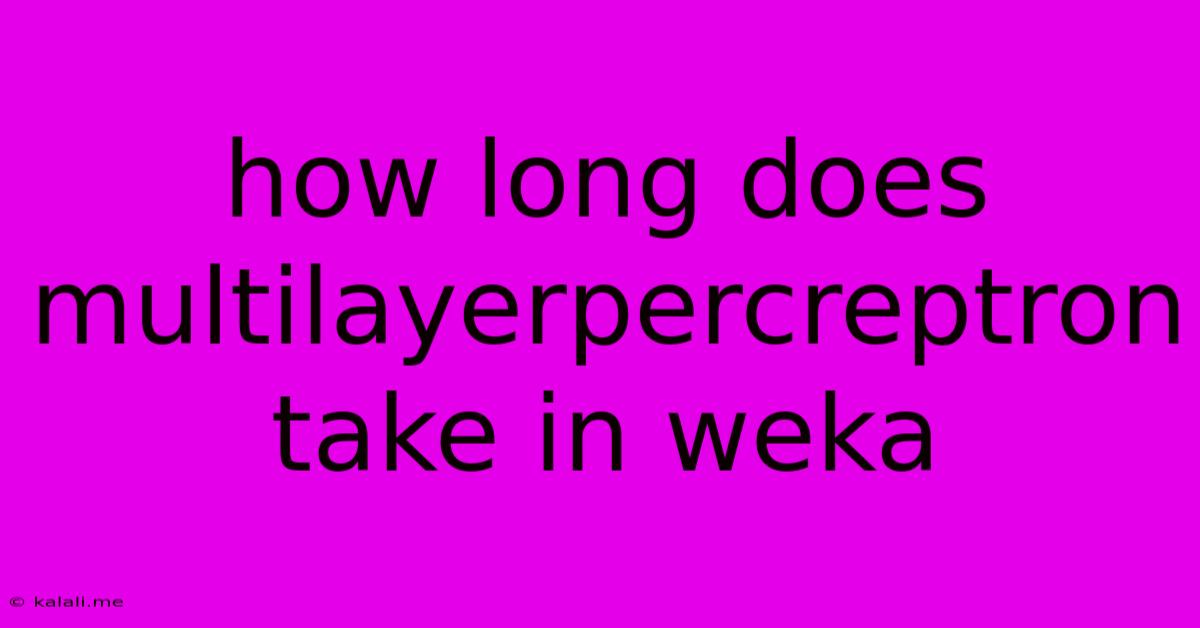How Long Does Multilayerpercreptron Take In Weka
Kalali
May 30, 2025 · 3 min read

Table of Contents
How Long Does a Multilayer Perceptron Take in Weka? A Deep Dive into Training Time
Training a Multilayer Perceptron (MLP) in Weka can take anywhere from a few seconds to several hours, even days, depending on several crucial factors. This article will dissect these factors, helping you understand and potentially optimize the training time of your MLP models in Weka. This is crucial for efficient machine learning workflow, especially when dealing with large datasets. Understanding these time constraints is essential for effective model building.
Factors Influencing MLP Training Time in Weka:
Several interconnected elements significantly impact the training time of your MLP in Weka. These include:
1. Dataset Size: The Bigger, the Longer
The most obvious factor is the size of your dataset. A larger dataset with more instances (rows) and attributes (columns) requires significantly more computation, directly translating to longer training times. Processing millions of instances and hundreds of attributes can easily consume considerable resources and time. Consider techniques like data sampling or dimensionality reduction to manage this.
2. Network Architecture: Complexity Matters
The architecture of your MLP plays a critical role. A deeper network with more hidden layers and neurons per layer will generally take longer to train than a shallower, simpler network. More connections mean more computations during the backpropagation algorithm, increasing the overall training time. Experiment with different architectures to find the optimal balance between performance and training time. Consider starting with simpler architectures and gradually increasing complexity.
3. Learning Rate and Algorithm: Finding the Right Pace
The learning rate, a hyperparameter controlling the step size during weight updates, significantly impacts training time. A very small learning rate might lead to slow convergence, requiring many iterations. Conversely, a very large learning rate might cause the algorithm to overshoot the optimal weights, resulting in slower convergence or even divergence. The choice of optimization algorithm (e.g., backpropagation with momentum, stochastic gradient descent, Adam) also affects training speed. Different algorithms possess varying convergence rates.
4. Stopping Criteria: Knowing When to Stop
The stopping criteria define when the training process terminates. Common criteria include reaching a specific number of iterations, achieving a desired level of accuracy, or observing no significant improvement in performance over a certain number of iterations. Defining appropriate stopping criteria prevents unnecessary computation and helps manage training time effectively. Carefully consider the trade-off between accuracy and training time.
5. Hardware and Software Resources: The Underlying Infrastructure
The computational resources available significantly influence training time. A faster processor, more RAM, and a dedicated GPU can dramatically reduce training time compared to a slower machine with limited resources. Similarly, the Weka version and its underlying Java Virtual Machine (JVM) configuration can also affect performance. Ensure your system is adequately configured to handle the demands of training your MLP.
6. Data Preprocessing: A Necessary Step
Preprocessing your data – including normalization, standardization, and handling missing values – is a crucial step that impacts training time indirectly. Well-preprocessed data can lead to faster convergence and reduce the overall training time. Neglecting this step might result in longer training and potentially less accurate models.
Optimizing MLP Training Time in Weka:
To reduce MLP training time in Weka, consider these strategies:
- Reduce Dataset Size: Employ techniques like stratified sampling to create a smaller, representative dataset for training.
- Simplify Network Architecture: Start with simpler architectures and gradually increase complexity only if necessary.
- Tune Hyperparameters: Experiment with different learning rates and optimization algorithms. Use Weka's cross-validation features to find optimal settings.
- Optimize Hardware: Utilize a machine with faster processors, more RAM, and a dedicated GPU if possible.
- Effective Data Preprocessing: Ensure your data is properly cleaned, normalized, and standardized.
By understanding these factors and implementing appropriate optimization strategies, you can significantly reduce the training time of your MLP models in Weka, ultimately enhancing your machine learning workflow. Remember that finding the right balance between training time and model accuracy is crucial for building effective predictive models.
Latest Posts
Latest Posts
-
Linus And Lucy Piano Sheet Music
May 31, 2025
-
My Hot Water Runs Out Quickly
May 31, 2025
-
What Happens If You Put A Battery In Water
May 31, 2025
-
Hack To Get A Discharge Hose To Fit Over Pipe
May 31, 2025
-
Is Joint Compound The Same As Plaster
May 31, 2025
Related Post
Thank you for visiting our website which covers about How Long Does Multilayerpercreptron Take In Weka . We hope the information provided has been useful to you. Feel free to contact us if you have any questions or need further assistance. See you next time and don't miss to bookmark.